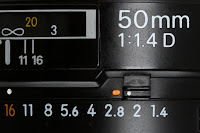For a compilation of the morning walk images, click here.
 |
Fuji X100S, 23mm F 2.0 lens. Incandescent WB setting, CTO bounce flash. |
I wanted to mix things up a bit because sunrise came later in the morning and I'd have a better chance of finding some sunrise backgrounds to use with some flash-enhanced photography. As is always the case, that which you don't prepare for will get in your way when push comes to shove.
I decided to bring a Fuji X100S so that I could have access to a wider range of flash-synchronized shutter speeds. I also wanted to experiment with using the incandescent white balance preset in the hopes of obtaining some rich, blue skies.

CTO gel haphazardly attached to the faceplate of the flash.
It took some precious minutes to locate a suitable flash. I grabbed a Flashpoint Zoom Mini from my compact camera bag, pealed a used full CTO gel from my refrigerator door, then used some tape "stitches" to attach it to the flash. This accomplished, I slipped the flash in my pocket, along with some spare batteries, and headed out. As a consequences of the delays, the sky was beginning to brighten up, and my hopes of a dark, moody sky disappeared.
At first, I had some difficulty getting a sharply focused selfie. This normally isn't a problem, unless you're confronting the "fly" in the auto-focus ointment: backlighting. Auto focus systems rely on locating a zone of high contrast within the AF sensor boundaries. I found that it stumbles when confronting compositions where the background is significantly brighter than one's foreground subject. These are often the exact conditions you encounter whenever you both want, and need, supplementary flash illumination.
I solved this using the same technique I employed for making selfies with my manually focused lenses using the neck strap as a convenient distance marker.

This unimaginative photo shows me stretching the neck strap with my thumb to establish a repeatable camera-to-subject distance. Then I pressed the AFL/AEL button to lock that specific distance. I cover the reasoning behind the process here.
Rather than my attempting to explain the application of the AFL/AEL button, I will refer you to Neil van Niekerk's excellent post of viewing and focusing options for the Fuji X100S. Here is a portion of that post.
"...Instead of twiddling the dial until the image snaps in focus, you can just press the AFL/ AEL button. (The red arrow in the diagram.) The focus is activated, and the camera auto-focuses for you … while you see the enlarged view. Perfect. This gives you instant accurate focus. And if you feel you can tweak it to focus a bit sharper, or that you’d rather focus on another part of your subject, then you turn the focus ring. The Spot-Focus method works very much like using Back-Button Focus on a DSLR. By letting go of the AFL/AEL button, the focus is now locked since the camera is in manual focus mode after all..."
The photo at the top of the post was lit by bouncing the flash, gel and all, off the side of a shingled home in my neighborhood. White Balance was set to 3700K, so he results were technically warmer by about 500K. I dare say the colors are accurate enough for most purposes.

We'll explore that shortly!


















